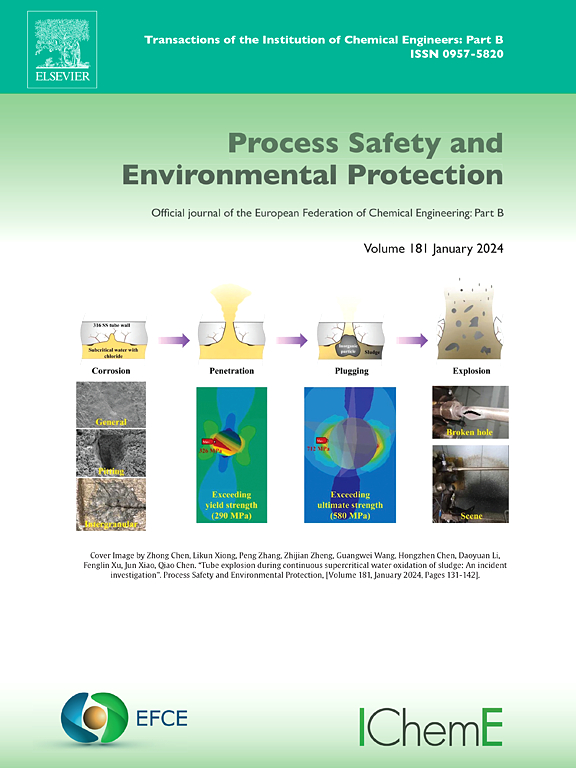A miniaturized electronic nose system based on sensor array for C2H4 concentration prediction
IF 6.9
2区 环境科学与生态学
Q1 ENGINEERING, CHEMICAL
引用次数: 0
Abstract
Ethylene (C2H4) is a highly flammable and explosive gas, which may cause severe hazards. To prevent the potential fire or explosion incidents and ensure the safety of chemical plants or surrounding environments, monitoring the concentration of C2H4 gas is essential. As a device for detecting gases, the electronic nose (E-nose) can effectively predict concentrations of gases, but traditional E-nose systems face challenges such as poor portability, high cost, and high-power consumption. In this study, a miniaturized, low-cost portable E-nose device was designed utilizing micro-electromechanical systems (MEMS) sensors, integrated with advanced deep learning algorithms, to achieve the real-time prediction of C2H4 concentrations. Subsequently, a dataset containing the samples originating from varying concentrations of C2H4, ranging from 10 to 100 ppm, was systematically collected. To enhance the prediction accuracy, a CE-CNN model was proposed, which integrates an Efficient Channel Attention mechanism into the Convolutional Neural Network, while Cosine Annealing Warm Restart strategy optimizes the training process by dynamically adjusting the learning rate. Compared to current popular algorithms, CE-CNN achieves the lowest mean absolute error (MAE) of 1.7286 and mean square error (MSE) of 2.1064, as well as the highest R-squared (R2) value of 0.9985 for C2H4 gas concentration prediction. Finally, edge computing was implemented on the designed portable E-nose device, enabling independent gas data collection, processing, and prediction, with a maximum concentration prediction error of only 6.80 % of the actual concentration.
基于传感器阵列的C2H4浓度预测小型化电子鼻系统
乙烯(C2H4)是一种高度易燃易爆气体,可能造成严重危害。为了防止潜在的火灾或爆炸事件,确保化工厂或周围环境的安全,监测C2H4气体的浓度是必不可少的。电子鼻作为一种气体检测设备,可以有效地预测气体的浓度,但传统的电子鼻系统面临着便携性差、成本高、功耗大的挑战。本研究利用微机电系统(MEMS)传感器,结合先进的深度学习算法,设计了一种小型化、低成本的便携式电子鼻装置,实现了对C2H4浓度的实时预测。随后,系统地收集了一个数据集,其中包含来自不同浓度C2H4的样品,范围从10到100 ppm。为了提高预测精度,提出了一种CE-CNN模型,该模型将高效通道注意机制集成到卷积神经网络中,余弦退火热重启策略通过动态调整学习率来优化训练过程。与目前流行的算法相比,CE-CNN预测C2H4气体浓度的平均绝对误差(MAE)最低为1.7286,均方误差(MSE)最低为2.1064,r平方(R2)值最高为0.9985。最后,在设计的便携式电子鼻设备上进行边缘计算,实现了气体数据的独立采集、处理和预测,最大浓度预测误差仅为实际浓度的6.80 %。
本文章由计算机程序翻译,如有差异,请以英文原文为准。
求助全文
约1分钟内获得全文
求助全文
来源期刊

Process Safety and Environmental Protection
环境科学-工程:化工
CiteScore
11.40
自引率
15.40%
发文量
929
审稿时长
8.0 months
期刊介绍:
The Process Safety and Environmental Protection (PSEP) journal is a leading international publication that focuses on the publication of high-quality, original research papers in the field of engineering, specifically those related to the safety of industrial processes and environmental protection. The journal encourages submissions that present new developments in safety and environmental aspects, particularly those that show how research findings can be applied in process engineering design and practice.
PSEP is particularly interested in research that brings fresh perspectives to established engineering principles, identifies unsolved problems, or suggests directions for future research. The journal also values contributions that push the boundaries of traditional engineering and welcomes multidisciplinary papers.
PSEP's articles are abstracted and indexed by a range of databases and services, which helps to ensure that the journal's research is accessible and recognized in the academic and professional communities. These databases include ANTE, Chemical Abstracts, Chemical Hazards in Industry, Current Contents, Elsevier Engineering Information database, Pascal Francis, Web of Science, Scopus, Engineering Information Database EnCompass LIT (Elsevier), and INSPEC. This wide coverage facilitates the dissemination of the journal's content to a global audience interested in process safety and environmental engineering.
 求助内容:
求助内容: 应助结果提醒方式:
应助结果提醒方式:


